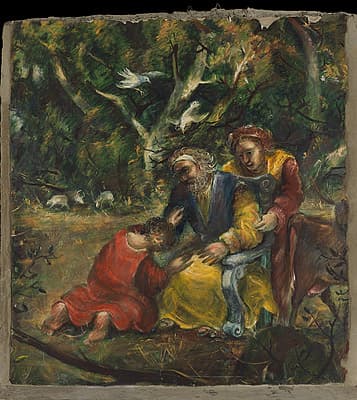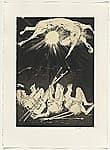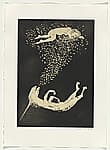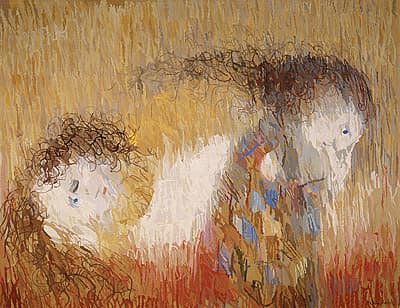About
Open 5 September – 9 November 2014 Canberra only
Arthur Boyd: agony and ecstasy brings together works that emphasise Boyd’s profound and inventive engagement with realms of the human condition. Among the many works that have not been exhibited before is The prodigal son, a large fragment of a mural that was painted by Arthur for his uncle, the well-known novelist, Martin Boyd. Undertaken in 1948 when Arthur was 28 years old, its original location was the dining room of a house known as The Grange, built by his great grandparents William Arthur Callendar (known as W.A.C.) and Emma (née Mills) à Beckett in 1866 at Harkaway near Berwick in Victoria.
The story of this mural could well be described as one of ecstasy and agony. It was Boyd’s largest commission and an extraordinary feat. Franz Philipp, who wrote the first major monograph on Boyd, considered the mural as the culmination of his religious works and a masterpiece of landscape painting, and the artist came to consider it as one of his best works. The prodigal son is set in a lush landscape reflecting the views outside, while the figures are painted in deep, rich colours suggesting the inspiration of artists he admired like Titian and Tintoretto.
 Arthur BoydThe prodigal son 1948–49 central scene from western wall of the Harkaway mural Gift of Arthur Boyd 1969
Arthur BoydThe prodigal son 1948–49 central scene from western wall of the Harkaway mural Gift of Arthur Boyd 1969Boyd’s mural took shape from late 1948 as he worked assiduously while playing Beethoven’s 7th Symphony ‘very loudly’. Painted in a ‘fresco secco’ method over a plaster ground it originally unfolded across an expanse of over 20 metres. The theme of the return of the prodigal son was a familiar one to Arthur and seemed apt in relation to Martin Boyd, who had returned to Australia after many years in England. The patriarchal figure also relates to repeated images that Arthur painted and drew of his own father, Merric, in a chair—although in this instance it has become a very sturdy throne.
While Martin Boyd had good intentions when he returned to Australia in 1948 to reclaim and restore the home, he did not ultimately find the answer to his dreams there and left Australia in 1951. Sadly The Grange was eventually sold and demolished to make way for a quarry. The process of attempted salvage of the mural caused Boyd much heartache. After years of thwarted attempts to save the mural, Boyd’s friend, the dealer Joseph Brown, assisted in the retrieval of four relatively large components and a few small pieces that eventually came under the auspices of the National Gallery of Australia. In order to save these components the decision was made by an engineer to encase the larger ‘fragments’ in concrete, which made them immensely heavy and a significant risk and challenge to display safely.
It has taken considerable effort from a team within the Gallery and with the advice of external conservators and engineers to find a way of safely moving The prodigal son fragment into the Gallery without damaging the mural fragment or the floors of the exhibition space. In recent times David Wise, Senior Paintings Conservator, has been conserving some of the damage to the work that occurred when The Grange was left vacant before its destruction. It is a momentous occasion to finally be able to exhibit this masterful component that is still part the wall of the house Boyd’s great grandparents built in 1866, in Arthur Boyd: agony and ecstasy.
While the subject of The prodigal son is one of regaining love and acceptance, other works in the exhibition are about the ongoing struggle involved in being an artist. Boyd’s Caged painter series, also sometimes referred to as the artist-in-extremis group of works, undertaken in the early 1970s, are brought together and recognised in this exhibition as some of the most brilliant works of his career. During a residency at the Australian National University from September 1971 until late February 1972, Boyd spent time in the local landscape, often painting in the company of his wife Yvonne. After more than a decade living in London (apart from a visit to Australia in 1968) Boyd was captivated by the bright light of a Canberra summer that seemed to be imbued into the landscape. As Yvonne recalled in a letter written to Alan McCulloch in 1972 (courtesy of the Bundanon Trust Archive):
[We] sat in Canberra, sometimes in the nearby (beautiful, beautiful) bush, Arthur painting the light again and trying quite frenziedly at times to get that Reckitt’s blue sky, me gathering sticks to light our fire and boil our billy. These days of Canberra summer when not quite washed out by rainstorms are for Arthur the purpose, justification and to a degree the consummation of the wish to be in Australia again.
Themes of entrapment and release that are so prominent in Boyd’s Caged painter series ran through works he undertook before, during and after his residency in Australia, in particular his collaboration with the poet Peter Porter on The lady and the unicorn. In Porter’s retelling of the tale, the hunters envision the capture of this crea≠ture—a symbol of purity beyond human understanding. In one instance the hunter is seen capturing the unicorn in a cage very like the ones in the Caged painter series.
 Arthur Boyd Figurepainting a shadow 1973 oil on canvas The Arthur Boyd gift 1975
Arthur Boyd Figurepainting a shadow 1973 oil on canvas The Arthur Boyd gift 1975 Another version of this idea is one of Boyd’s most astonishing images The hunters set out to trap the unicorn, which engages directly with William Blake’s The Stygian Lake, with ireful sinners fighting, from a series inspired by Dante’s The Divine Comedy (1824–27). In Boyd’s print, he reverses the images of the hunters and the hunted— the men with swords lie on the ground as the miraculous unicorn arches above them, over the sun. An excerpt from Porter’s poem reveals the shared potency of the visionary capacities of both poet and artist.



Left to right: The unicorn and the ark, The hunters set out to trap the unicorn, The unicorn sees the lady 1975 etching and aquatint sheet purchased 1978 reproduced with the permission of Bundanon Trust
There are references in letters between Porter and Boyd to the Cluny Museum in Paris and the wonderful medieval tapestries on the theme of the lady and the unicorn. Boyd was familiar with the tapestries created in the style of ‘mille-fleurs’ (a thousand flowers) and his prints The unicorn sees the lady and The lady betrays the unicorn are among the most exquisite works in his oeuvre. In the former the unicorn lies swooning on its back; the tiny precise white leaf patterns against velvet black aquatint rising up to encompass the lady of his dreams.
 Arthur Boyd designer Tapeçarias de Portalegre manufacturer St Francis when young turning aside 1972 purchased 1975
Arthur Boyd designer Tapeçarias de Portalegre manufacturer St Francis when young turning aside 1972 purchased 1975 reproduced with the permission of Bundanon Trust
In addition to paintings and prints there is a room in the exhibition featuring Boyd’s St Francis tapestries woven at the Tapestry Workshop in Portalegre in the early 1970s, which have rarely been seen together. These weavings capture the vitality of Boyd’s original pastel drawings. Seen as a group they reveal the agony and ecstasy of St Francis in ways that were quite distinctive to Boyd’s vision. As the examples discussed in this brief article indicate, the exhibition Arthur Boyd: agony and ecstasy brings together diverse works across a range of themes. Spanning a timeframe of just over three decades, the exhibition reveals Boyd as one of the truly great inventive artists of the twentieth century.
Deborah Hart
Senior Curator,
Australian Paintings and Sculpture post-1920
SOURCE: Artonview 79

